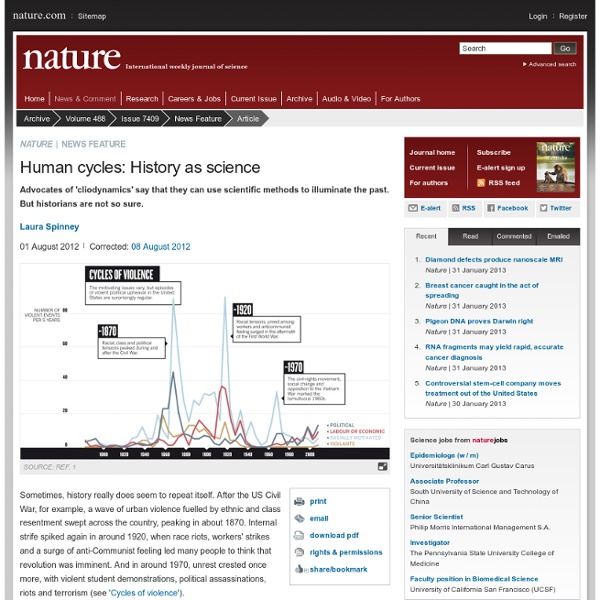Human cycles: History as science

History's Most influential people ranked by wiki reach
This article was taken from the November 2012 issue of Wired magazine. Be the first to read Wired's articles in print before they're posted online, and get your hands on loads of additional content by subscribing online. This infographic reveals the world's most influential people, born before 1950, using data from all language editions of Wikipedia. Rankings are based on parameters such as the number of language editions in which that person has a page, and the number of people known to speak those languages (L/BN). Using this quantitative approach, Hidalgo is now testing hypotheses such as whether cultural development is structured or random. View the full-size image in our gallery
Retronaut - See history.
History Major
The History Major is divided into a core program, six geographical concentrations, and a series of electives. You will be required to first complete the core program (HIST101 through HIST104), which is designed to provide you with a broad, comparative overview of world history and equip you with the tools you will need to conduct historical research and utilize primary sources for historical analysis. You will then take HIST201 through HIST212 as well as two additional 200-level courses with a non-western geographical concentration (Latin and South America, the Middle East and Southwest Asia, East Asia, or Sub-Saharan Africa). These specialized courses will familiarize you with specific historical events and trends within each of these geographical sub-fields. To fulfill the requirements for this major, you must complete the core program (4 courses), 6 geographical concentration courses (6 courses), and 3 300-level electives of your choice (3 courses) for a total of 13 courses.
A moving story: with afterword - Jocelyn Cohn and James Frey
In 2012, workers at a small moving company in New York City rose up against bad pay and dangerous work conditions. In the course of the struggle, much was revealed about how exploitation operates; how the enticements of 'self-expression' and a 'laid back' atmosphere serve to weaken consciousness and collective action. At the same time, this history reveals the opportunities and limits that workers face within self-organized struggles in a small business format. In the Summer of 2012 the exploited workers at Rabbit Movers autonomously organized our shop and began the fight for control over the conditions of our lives. “They Just Run Us Into The Ground...” Our struggle was born in the cabs of box trucks all over the city. Work in our shop comes in a pattern of feast or famine. “My Mover Has Read Goethe!” We have all worked plenty of “shit jobs” before and came to this company with no illusions about the nature of precarious work in the present day. “My mover has read Goethe!”
HIST 102: World History II - Download free content from Harrisburg Area Community College
BEFORE THEY PASS AWAY
The purity of humanity exists. It is there in the mountains, the ice fields, the jungle, along the rivers and in the valleys. Jimmy Nelson found the last tribesmen and observed them. He smiled and drank their mysterious brews before taking out his camera. He shared what real people share: vibrations, invisible but palpable. He adjusted his antenna to the same frequency as theirs. There is a pure beauty in their goals and family ties, their belief in gods and nature, and their will to do the right thing in order to be taken care of when their time comes. ‘’In 2009, I planned to become a guest of 31 secluded and visually unique tribes. Elegant and evocative portraits created with a 4x5 camera. THE BOOK - XXL LIMITED EDITION 500 exclusive and numbered copies of this XXL book, offered in a sumptuous clamshell box, showcased on a custom-made transparent book holder and containing three autographed art prints. Purchase›
HIS 101: Hist Of Western Civ I - Download free content from Parkland College
HIST 101: World History I - Download free content from Harrisburg Area Community College
The History and Geography of Inventions
[Home Page][Other Page] [Search Inventions] [Before 10,000 BC][10,000 BC to 4000 BC][4000 BC to 3000 BC][3000 BC to 2000 BC][2000 BC to 1000 BC][1000 BC to 1 BC][1 AD to 1000 AD][1000 to 1500][1500 to 1700][1700 to 1800][1800 to 1850][1850 to 1900][1900 to 1950][Since 1950] [Inventions][Biographies][Religions of the World][Bible Contradictions][Rain][Countries of the World][Cookery][Music][Composers (Opera)] [Readers' Feedback (Religion)] [Language][Travel][Eclipses][London][Astronomy][Mathematics][Physics][Chemistry][Biology][Football][Television][Other] Sponsored Link
Related:
Related:



